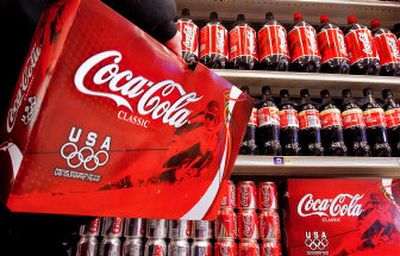Sweet talk

No one nagged or hounded. No one said, “Turn that TV/computer/video game off and go outside and play.” No one took the chips away, locked down the vending machines, or foisted vegetables on anyone.
With all the myriad theories about why children are getting fatter, researchers in Massachusetts focused on just one piece of the childhood obesity puzzle – sugar-sweetened drinks. Their study, published in the March issue of the journal Pediatrics, showed for the first time that simply cutting back on sugary drinks can reduce body fat.
The findings – along with other recent research on beverages’ role in weight gain – shed light on the importance of what Americans swallow in liquid form.
Scientists made it easy for the teens, ages 13 to 18, who altered their behavior for the study. They had a supermarket chain deliver weekly shipments of the teens’ preferred beverages, enough for four servings a day for the study participants plus two extra servings for each additional family member to avoid fights.
Half of the 103 teenage volunteers continued to drink as they normally did. Normal for the entire group before the study began was 2.5 servings of soda, fruit juices, sports drinks, lemonade or other sweetened drinks, or about 375 calories worth a day. The other half got to choose any kind of noncaloric drink they wanted.
Periodically, researchers would call the teens receiving noncaloric drinks with a pep talk. “We called to see how the deliveries were going, to ask if they had questions or if they wanted to change their beverage order,” says Cara Ebbeling, nutrition researcher at Children’s Hospital in Boston and lead author of the study. Every time the subjects opened their refrigerators, they would see a magnet saying, “Think before you drink.”
After six months, volunteers in the control group had gained a little weight. The no-sugar-drinks group wasn’t perfect, but members did cut their consumption of sweetened drinks by 82 percent – and lost a modest amount of weight. The biggest body mass loss, amounting to about a pound a month, occurred among teens who cut down on sweet drinks and were the most overweight at the start of the study.
Weight loss tied to fewer sweetened drinks, says Dr. William Dietz, director of the division of nutrition and physical activity at the Centers for Disease Control and Prevention, is an important piece of beverage research that has been missing. Other studies have suggested that increasing the amount of high-calorie soft drinks can increase weight, but this is the first to show that reducing the amount of sugary beverages can reduce weight.
“This study fits neatly,” Dietz says. “The trend to reduce weight was modest, but it was a trend in the right direction.”
Sodas, both sweetened and unsweetened, have become the No. 1 drink choice for adolescent girls, according to another recent study, this one published in the February issue of Pediatrics. Researchers followed 2,371 girls, ages 9 to 19, over a decade. In that time, their milk consumption went down by more than 25 percent, while soda intake nearly tripled. And that, says Dietz, is a major concern. The teen years are when girls most need calcium, abundant in milk products, to build bones and reduce the future risk of osteoporosis.
All liquid, says Barry Popkin, professor of nutrition at the University of North Carolina, needs further attention in diet studies. In research published in the March issue of the American Journal of Clinical Nutrition, he and a panel of nutrition scientists propose beverage consumption guidelines. Water is at the top of their list, followed by unsweetened tea and coffee and low-fat or nonfat milk or soy beverages. Even juice that is 100 percent fruit juice is, according to the experts, less preferable than diet sodas. “It’s better to eat real fruit,” Popkin says. “These juices have as many calories as sweetened soft drinks, with minimal nutrition.”
Every liquid calorie is a calorie added to the day’s total. “Liquid calories aren’t filling us up,” Popkin says. “It doesn’t change what you eat that day.” Over the last 20 years, Americans have added between 150 and 300 calories to their daily diets – about half of them in liquid form.
In the most recent study, the teens who drank less sugar did, apparently, think before they drank. Of course, one of the reasons they may have stuck with the study was that they were rewarded, at the end, with $100 gift certificates at a local mall. One can only hope they don’t use them to buy frappuccinos.